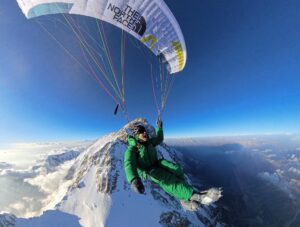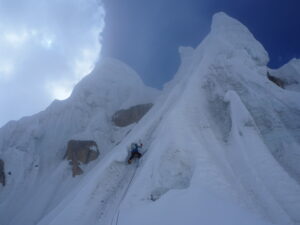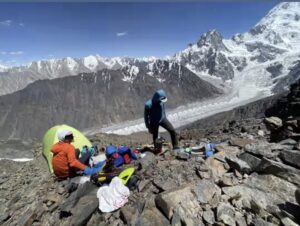Marek Holecek and Radoslav Groh had to turn back earlier this week on Masherbrum. And now Tom Livingstone of the UK and Ales Cesen of Slovenia had to do the same on Gasherbrum III. With the high success rate on guided 8,000m peaks, we sometimes forget that big mountains are hard. At least, for those on unclimbed routes with no support except the gear that they themselves carry.
Only summited twice
The third-highest Gasherbrum is only 48m shy of 8,000m. That immediately attracts serious alpinists — fewer guided collectors to contend with. Its approach is also longer and trickier than the way to its two taller brothers. Climbers must first get up part of GII’s Southwest Ridge, then turn left to GIII.
On the other hand, Gasherbrum III is not quite as challenging and aesthetic as the slightly lower but difficult Gasherbrum IV.
No wonder GIII has been summited only twice. And yet, both times were epic. The legendary Wanda Rutkiewicz, together with Alison Chadwick-Onyszkiewicz, Janusz Onyszkiewicz, and Krzysztof Zdzitowiecki made the first ascent in 1975 via the East Face. Basque climbers Alberto Iñurrategi and Jon Beloki made the second ascent in 2004.
Livingstone and Cesen hoped to bag the third ascent via a new line. They knew the odds were against them, and as it turned out, the odds won.

Cloud art over Gasherbrum III. Photo. Ales Cesen
Wind decided
In a brief report, Ales Cesen explained that they reached 7,800m. Beyond that point, they saw no way to advance further, mainly because of high winds. They decided the only wise thing to do was to turn around, as Holecek and Groh decided about their own attempt on Masherbrum’s West Face.
“I am still…proud of our decisions to make the climbing and descending reasonably safe at all stages,” Cesen said.
Social media climbing and helicopters
The duo will post further when they arrive home. As Tom Livingstone wrote before leaving for Pakistan, he sees no point in publicizing climbs before or during an expedition.
“Imagine having a guy sit in base camp who gets all your photos and videos, runs down the valley for a few days to get a signal, and then posts on your account? How mad is that?” wondered Livingstone. Some teams in Pakistan this summer were doing exactly that, he avers.

Tom Livingstone at home before the GIII expedition. Photo: Tom Livingstone/Instagram
Livingstone also used social media to throw a little shadow on “two teams who did great climbs last year” but were airlifted from the mountain (above Base Camp). He wonders whether these were helicopter rescues and therefore not a complete climb. It isn’t a coincidence that this is exactly what happened to Holecek and Groh on Baruntse last year.
Livingstone did not need a helicopter after attempting Gasherbrum III, nor did he need one after succeeding on Tengkampoche’s Northeast Pillar in Nepal last year. Still, for different reasons, his own 2021 climb was not free from controversy.






